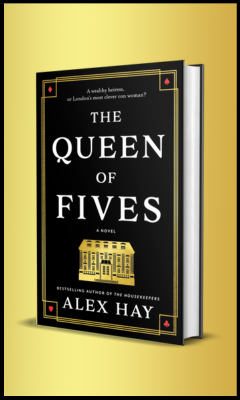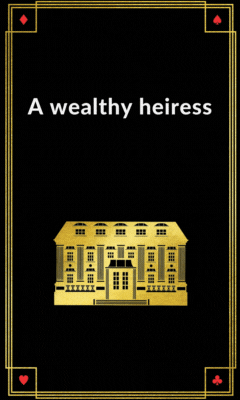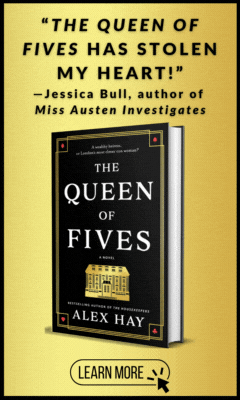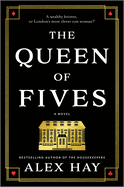The Queen of Fives
by Alex Hay
The title of Alex Hay's stylish and cheeky second novel, The Queen of Fives, refers to Quinn Le Blanc, the latest in a dynasty of London con artists based out of "The Château." In August 1898, Quinn resolves to pose as a debutante and marry Maximilian, the Duke of Kendal, for his fortune. According to the Château's century-old Rulebook, there are five steps to any confidence scheme: the Mark, the Intrusion, the Ballyhoo, the Knot, and the All In. Each step is allotted just one day to accomplish, so reeling in a mark should take less than a week. But Quinn hasn't reckoned with the obstructions she'll encounter in the form of Max's equally shrewd stepmother, Lady Kendal, and sister, Victoria.
At age 35, Victoria, nicknamed "Tor," finds herself in the precarious, although chosen, position of a spinster. She and Max have an arrangement, though. He vowed to also remain unmarried so that she can retain her position at Kendal House (if he married and produced an heir, she would be displaced and lose her promised fortune). Max has more than one reason to stay single, and has always shunned the trappings of royalty, so when Tor hears that he will be accompanying Lady Kendal to an audience in the queen's drawing room, Tor's suspicion is immediately aroused. And when she hears vague words of marriage prospects for Max, she knows something has gone terribly awry.
Meanwhile, Quinn has launched her confidence scheme. She keeps spies and collaborators everywhere, and all it generally takes is a spot of bribery or blackmail to get the information or access she needs. A corrupt archdeacon gains her a place at the audience, where she will adopt the alias "Miss Quinta White." Mrs. Airlie, herself a former confidence woman, will play her cousin and introduce her at court.
With her right-hand man, Mr. Silk, Quinn engineers a dramatic incident on the day of the royal audience: a fellow debutante brandishes a pistol in a would-be assassination attempt only for Quinta to save the day, earning the duke's attention and making it into newspapers. Rumors soon spread about this Miss White. Where did she come from? Who is she to think she can consort with royalty? When the duke announces his engagement to her just three days after their meeting at court, the gossip mill goes into overdrive.
Hay conveys a vivid sense of Victorian high society via the main characters' pastimes--Quinn and Max's trips to the opera and the Summer Exhibition, Tor's obsession with racehorses, Max's botany hobby, Max and Tor's carriage races, Lady Kendal's support of charitable causes--and Max's 30th-birthday ball. The narrative involves various London locales, as the city's boroughs reveal their different personalities and reputations. The action alternates between the shabby dignity of the Château and its maze of surrounding alleys at the edge of East London's Spitalfields and the Kendals' opulent redbrick mansion on Berkeley Square, with occasional scenes set at Buckingham Palace.
Quinn, being a master of disguises, travels easily across all of these settings. In one dazzling sequence, she enters Kendal House dressed as a flower seller and strips off layers of costumes to impersonate, in turn, a maid, an errand boy, and a chimney sweep so that she can pass through the mansion unnoticed to gather intelligence about Lady Kendal and Tor.
Hay makes lighthearted use of period literary allusions. The opening line echoes Jane Eyre: "There was no suggestion that Quinn might be allowed to dress herself" (compare that to Charlotte Brontë's "There was no possibility of taking a walk that day"). Several character names make reference to fabrics: along with Mr. Silk, there are two shadowy figures flitting through, initially known only as "the man in the blue silk waistcoat" and "the woman in the cream silk gown." The latter is reminiscent of the title character in Wilkie Collins's The Woman in White, the quintessential sensation novel.
Meanwhile, the novel's banter and tone also recall the work of Oscar Wilde, with the five days of the action evoking the structure of a five-act play, for Quinn is not the only character who is playing a role here. At the time of their engagement, she and Max agree that theirs will be a marriage of convenience, based on money and appearances rather than true love. "Marriage need not interfere with a gentleman's private pleasures," as their mutual adviser Mr. Willoughby puts it discreetly. The soupçon of sexual secrecy that ensues is tantalizing.
Like Hay's Caledonia Novel Award-winning debut, The Housekeepers, this is a playful romp featuring strong female characters. Readers get the delight of peeking into multiple strata of British society, from the highest echelons down to servants and common criminals. Such stories of historical intrigue build on perennial interest in the royals, as spread by the media then and now. It's a classic literary device to end with a wedding--Shakespeare did so, after all. Nuptials are promised in the prologue, but there are many surprises and double crossings yet to come. This mischievous and theatrical story entertains at the same time as it deals shrewdly with matters of gender, class, and power. --Rebecca Foster








